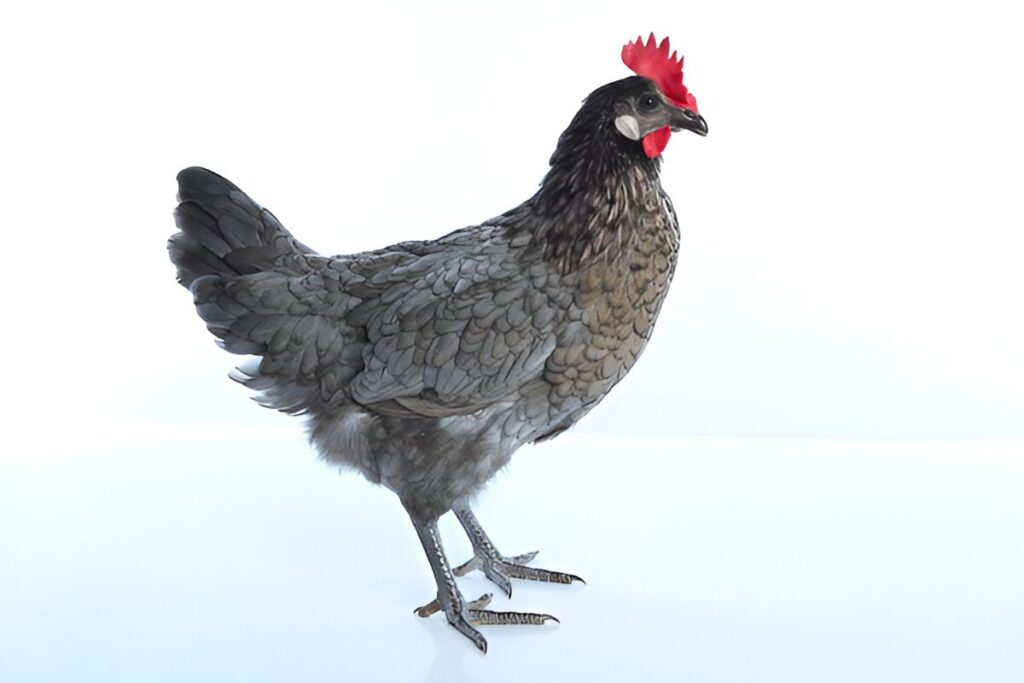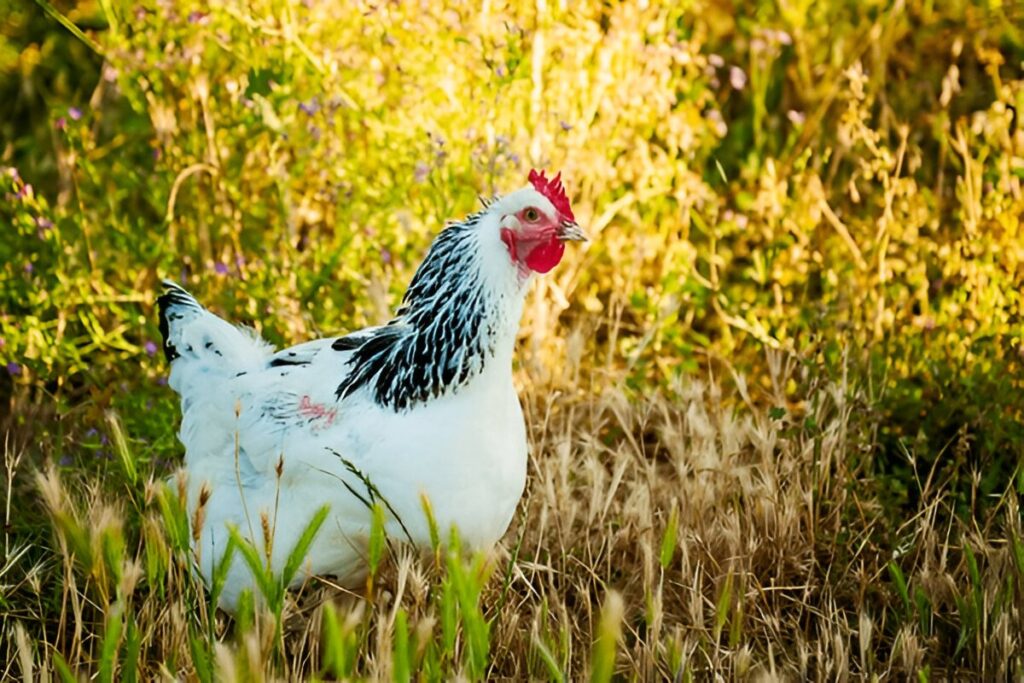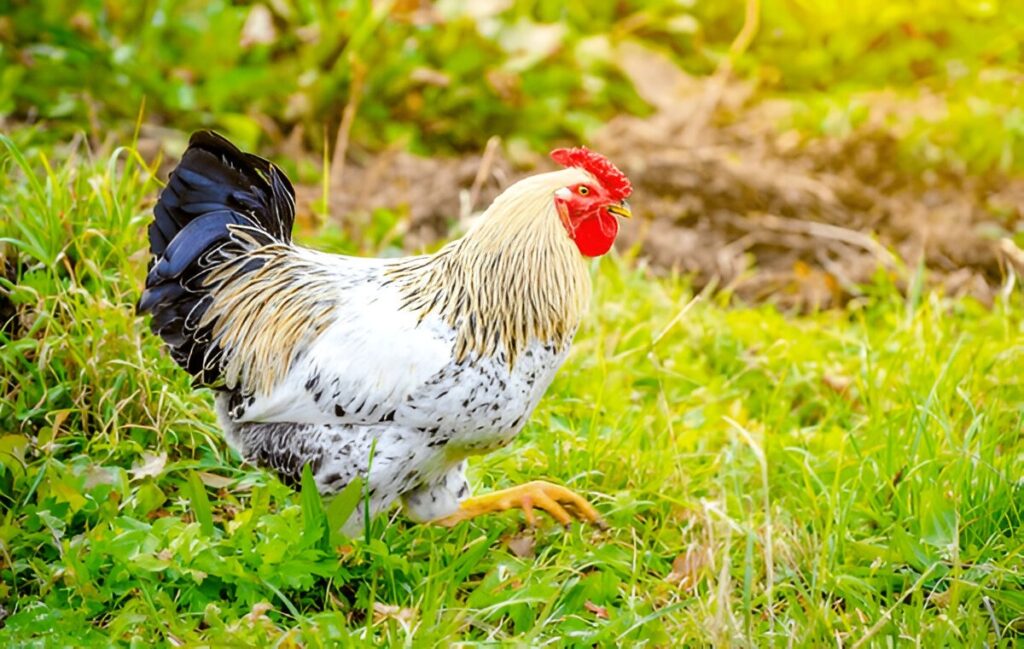
With their striking barred plumage, gentle nature, and reliable productivity, Delaware Chickens are a testament to America’s poultry heritage.
Whether you’re a homesteader in Pennsylvania, a backyard keeper in Georgia, or a 4-H enthusiast in Ohio, this guide explores why Delawares are a timeless choice for U.S. flocks.
What Is a Delaware Chicken?
The Delaware Chicken is a dual-purpose breed developed in the U.S. in the 1940s. Known for their white feathers accented with black barring on the neck and tail, they excel in both egg and meat production.
Key Traits:
- Size: Roosters – 7–8.5 lbs; Hens – 5.5–6.5 lbs.
- Appearance: White body with black barring on the hackle and tail; yellow legs, single comb.
- Egg Production: 180–220 large brown eggs/year.
- Temperament: Calm, friendly, and easy to handle.
APA Recognition:
Accepted by the American Poultry Association (APA) in 1952.
The History of Delaware Chickens: A U.S. Poultry Icon
Origins in the 1940s
Delawares were developed in Delaware by crossing Barred Plymouth Rock roosters with New Hampshire Red hens.
Initially bred for the broiler industry, they were later overshadowed by Cornish Cross but retained popularity among small farms for their versatility.
Cultural Legacy
By the 1960s, Delawares became a symbol of sustainable farming, prized for their ability to thrive without industrial inputs. Today, they’re celebrated in states like Maryland and Virginia for their historical significance and utility.
Did You Know?
Delawares were among the first breeds used in the U.S. commercial poultry industry before hybrids took over.

Why Raise Delaware Chickens in the USA?
1. Dual-Purpose Excellence
- Eggs: Consistent layers, even in colder months.
- Meat: Tender, flavorful meat ideal for small farms.
2. Calm & Family-Friendly
Docile and trusting, they’re great for families and 4-H projects.
Real-Life Example:
The Miller family in Kentucky shares: “Our Delawares follow the kids around the yard like feathered puppies. They’re our friendliest birds!”
3. Cold-Hardy Design
Their small single comb and dense feathering minimize frostbite risk, perfect for northern winters.
4. Historical Appeal
A living piece of American agricultural history, ideal for heritage farms.
Caring for Delaware Chickens: A U.S.-Focused Guide
1. Coop & Run Setup
- Space: 3–4 sq ft/bird indoors; 8–10 sq ft in runs.
- Predator-Proofing: Use ½-inch hardware cloth – raccoons and foxes target docile breeds.
- Roosts: Medium height (18–24 inches) – they’re moderate flyers.
Pro Tip:
In snowy regions like Minnesota, insulate coops with straw and use heated waterers (Farm Innovators®).
2. Diet & Nutrition
- Chicks (0–8 weeks): 20% protein starter crumble (e.g., Purina® Start & Grow).
- Adults: 16% layer pellets with oyster shell supplements.
- Treats: Mealworms, leafy greens, and squash.
Sample Feeding Schedule:
| Time | Feed | Amount |
|---|---|---|
| Morning | Layer pellets | ⅓ cup/bird |
| Afternoon | Veggies/greens | ½ cup/flock |
| Evening | Scratch grains | ¼ cup/flock |
3. Health & Grooming
- Feather Care: Check for mites weekly; dust with diatomaceous earth.
- Common Issues:
- Frostbite: Apply petroleum jelly to combs in extreme cold.
- Broodiness: Discourage by collecting eggs promptly.
4. Seasonal Adjustments
| Season | Challenge | Solution |
|---|---|---|
| Winter | Frozen waterers | Use heated bases. |
| Summer | Heat stress | Provide shade and frozen watermelon. |
| Molting | Feather loss | Boost protein with sunflower seeds. |

Delaware Chickens vs. Other Dual-Purpose Breeds
| Breed | Eggs/Year | Temperament | Key Trait | Best For |
|---|---|---|---|---|
| Delaware | 180–220 | Calm, friendly | Historical, barred | Heritage farms |
| Plymouth Rock | 200–220 | Docile | Barred plumage | Free-ranging |
| Rhode Island Red | 250–300 | Active | High egg yield | Egg production |
| New Hampshire Red | 200–240 | Hardy | Fast growth | All climates |
Why Delaware Wins:
Balanced productivity, historical charm, and adaptability to small-scale farming.
Challenges of Raising Delawares
1. Broodiness
- Problem: Hens may go broody, pausing egg production.
- Fix: Use a broody breaker cage or collect eggs daily.
2. Availability
- Problem: Less common than Rhode Island Reds.
- Fix: Source chicks from heritage hatcheries like Murray McMurray.
3. Moderate Egg Production
- Problem: Lay fewer eggs than Leghorns.
- Fix: Pair with high-production breeds for a balanced flock.
Breeding & Showing Delawares in the USA
Breeding Tips
- Selecting Stock: Choose birds with crisp barring, broad breasts, and no leg feathering.
- Incubation: Eggs hatch in 21 days. Use a Brinsea® Advance EX incubator.
Show Preparation
- Grooming: Bathe with Espree® Aloe Vera Shampoo for glossy feathers.
- APA Standards: Judges prioritize clean barring and upright posture.
Top U.S. Shows:
- Ohio National Poultry Show
- Delaware State Fair
- Virginia Poultry Expo
FAQs About Delaware Chickens
Q: How many eggs do Delawares lay?
A: 4–5 eggs weekly, with steady production in winter.
Q: Are Delaware roosters aggressive?
A: Rarely – they’re among the calmest dual-purpose roosters.
Q: Can they handle cold climates?
A: Yes! Their small comb and dense feathers suit states like Maine.
Q: Are they good for meat?
A: Yes – meat is tender, though leaner than Cornish Cross.
Q: Where can I buy Delaware chicks?
A: Trusted hatcheries like Cackle Hatchery or local breeders.
Q: Are they noisy?
A: Hens cluck softly; roosters crow moderately.
Q: How long do they live?
A: 6–8 years with proper care.
Q: Can they live with other breeds?
A: Yes! They’re non-confrontational and mix well with Orpingtons.
Q: Are Delawares good for beginners?
A: Absolutely – low-maintenance and friendly.
Ready to Preserve Poultry History?
From heritage farms to modern backyards, Delaware Chickens offer eggs, meat, and a connection to America’s agricultural past. For expert advice on raising these classic birds, contact Chickiq.com’s poultry specialists.
Barred Beauty, Timeless Utility! 🐔
